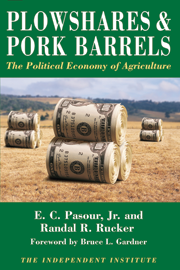Michael Dukakis suggested, during the Iowa primary campaign, that U.S. farmers should consider the production of alternative products such as Belgian endive. This proposal that farmers experiment with new types of agriculture has elicited snickers ever since, but it raises a couple of interesting issues. What is the potential for production of nontraditional crops and livestock? How do government farm programs affect farmers’ incentives to experiment with new types of agriculture?
There is a great deal of interest throughout the U.S. in alternatives to conventional field crops and livestock. Such nontraditional products include shiitake mushrooms, evening primrose, kiwi fruit, ginseng and other local herbs, jams and jellies. Rabbit meat and goat meat are among the specialty animal products receiving consideration. In the Southeast, there is growing interest in aquaculture, especially the production of catfish on a commercial scale.
Unfortunately, while there are many opportunities for astute entrepreneurs to discover and fill market niches for specialty agricultural products, these markets quickly become saturated. The problems in substituting alternative crops for field crops can be seen by looking at tobacco.
Because of the dangers of tobacco use, some anti-smoking groups have called for an end to tobacco production in the U.S. and the substitution of broccoli and other specialty crops. However, tobacco acreage in North Carolina alone is more than double the current broccoli acreage in the whole country. Moreover, the market for most farm products is quite sensitive to increases in output. If output is increased, say, 10%, product price is likely to decrease more than 10%. Thus, large increases in broccoli (and other horticultural products) would result in dramatic reductions both in product prices and in incomes of existing and new producers.
Consequently, it is unlikely that any single activity will offer a significant number of U.S. farmers a viable production alternative to conventional cash crops. Moreover, increases in vegetable production also are limited by perishability problems and the inability of many producers to secure reliable market outlets.
Despite these problems, thousands of farmers throughout the U.S. have discovered niche opportunities both in producing new products and in producing and marketing conventional products in new ways. In addition to the products mentioned earlier, other profitable alternatives for some farmers include Christmas trees, fireplace logs made of compressed wheat or hay straw, and baled pine straw for mulching in home lawns and gardens.
New production and marketing methods include organic or low-pesticide farming; intensive cropping procedures using plastic mulches; greenhouse-growing of lettuce and other vegetables, and "pick-your-own’ fruit and vegetable farms. The producer challenge is to coordinate expanded production with better marketing.
It also should be recognized that an increase in demand for alternative food products is likely to decrease domestic consumption of traditionally produced products. Individuals who eat more rabbit meat, for example, must eat less of other foods if they are not to gain weight.
Furthermore, the fact that a specialty crop, like Belgian endive, currently is largely imported does not imply that a production opportunity exists for U.S. farmers. Any crop grown throughout the world can be produced in the U.S. at some cost. But comparative advantage is just as important in determining, the most efficient geographical pattern of production for specialty crops on an international basis as it is for wheat, corn or cotton. The challenge for any farmer is to determine the most profitable use of available resources, including land, labor and capital.
The existence of government price-support programs for conventional products tends to decrease the incentive to search out entrepreneurial opportunities of these kinds. Moreover, generally there are increased risks of producing and marketing products in unconventional ways.
Dukakis’s onetime focus on Belgian endive is certainly praiseworthy insofar as it promotes increased entrepreneurial activity in U.S. agriculture. However, it should be recognized that new crops and new production and marketing techniques are not the answer to current farm woes. Farm problems of the 1980s are, at least in part, rooted in protectionist government programs that misallocate resources, raise production costs, and stifle entrepreneurship. The overproduction incentive and adverse side effects of farm programs will be eliminated only when the incentive to produce for the government is replaced by the incentive to produce for the market.
It is ironic that Mr. Dukakis has proposed a greater use of production quotas as a way of raising farm product prices and reducing government outlays on farm programs. Increased cartelization of agriculture implies that U.S. farmers would be more dependent on government and less reliant on entrepreneurship.









